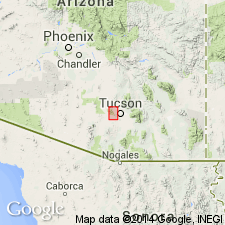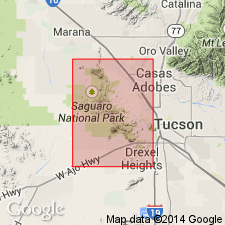
- Usage in publication:
-
- Tucson Mountain chaos
- Modifications:
-
- Named
- Dominant lithology:
-
- Breccia
- Conglomerate
- AAPG geologic province:
-
- Basin-and-Range province
Summary:
Named for Tucson Mountains, Pima Co, AZ, Basin-and-Range province. No type locality designated. Term "chaos" used as a descriptive term of formation rank. Crops out extensively in Tucson Mountains as tabular unit 14 mi long by 2-4 mi wide. Forms gentle, rolling topography. Unit is up to 400 feet thick with greatest thickness in central part of east side of range. Divided into lower conglomerate and upper chaos members. Conglomerate member occurs locally at Cat Mountain, near Gates Pass, and south of Ajo Road. At Cat Mountain, base of conglomerate member consists of poorly consolidated, well-rounded, reddish-brown cobble conglomerate with many boulders; cobbles and boulders are arkose, siltstone, and red beds of Amole group and dark andesite porphyry; upper part has more boulders and is well consolidated; maximum thickness of conglomerate member is 150 feet. Upper chaos member characterized by blocks about 10-200 feet in maximum dimension; blocks consist of Amole group, Paleozoic limestone, and other older rocks of Tucson Mountain area. Unconformably overlies pre-Laramide rocks; conformably underlies Cat Mountain rhyolite. Unit probably represents a talus pile that accumulated in front of a post-Laramide fault scarp; talus pile then slid down low gradient slope because of seismic activity. Cross section; geologic map (elsewhere in volume). Tentatively assigned early to middle Tertiary age.
Source: GNU records (USGS DDS-6; Denver GNULEX).

- Usage in publication:
-
- Tucson Mountain Chaos*
- Modifications:
-
- Overview
- AAPG geologic province:
-
- Basin-and-Range province
Summary:
Several features of unit suggest that it is a caldera-collapse megabreccia (megabreccia defined as a caldera-collapse breccia in which clasts are so large that fragmental nature of deposit is obscure): 1) contains fragments, all of local older formations, ranging from a few centimeters to 60 m in diameter; 2) rests discordantly on older rocks but occurs concordantly just below Cat Mountain Rhyolite, a thick ash-flow sheet; and 3) in places unit has a pyroclastic matrix, and typically grades upward into lithic-rich lower parts of Cat Mountain. Occurs in Tucson Mountains, Pima Co, AZ, Basin-and-Range province. Late Cretaceous age.
Source: GNU records (USGS DDS-6; Denver GNULEX).

- Usage in publication:
-
- Tucson Mountain Chaos†
- Modifications:
-
- Abandoned
Summary:
Abandoned. Rocks reassigned to megabreccia member of Cat Mountain Tuff (revised). [Author uses original spelling "Tucson Mountain chaos" of Kinnison (1959).] Study area is Tucson Mountains, Pima Co, AZ, Basin-and-Range province. Megabreccia member consists of clasts of diverse precaldera rocks surrounded by matrix of variably welded Cat Mountain Tuff and intermixed finely comminuted disaggregated block material. Author lists previous interpretations of origin of chaos. Interpreted in this study (as well as earlier studies by author) as synvolcanic landslide deposits derived from walls of Tucson Mountain caldera during ash-flow eruptions and attendant caldera collapse. Term Tucson Mountain chaos of Kinnison (1959) thus has no significance as a unit separate from Cat Mountain Tuff. Individual megablocks are as much as several hundred meters across, though single large blocks can be difficult to distinguish from monolithologic aggregates of smaller blocks. In this report areas of megabreccia are subdivided by dominant conspicuous clast type.
Source: GNU records (USGS DDS-6; Denver GNULEX).
For more information, please contact Nancy Stamm, Geologic Names Committee Secretary.
Asterisk (*) indicates published by U.S. Geological Survey authors.
"No current usage" (†) implies that a name has been abandoned or has fallen into disuse. Former usage and, if known, replacement name given in parentheses ( ).
Slash (/) indicates name conflicts with nomenclatural guidelines (CSN, 1933; ACSN, 1961, 1970; NACSN, 1983, 2005, 2021). May be explained within brackets ([ ]).

